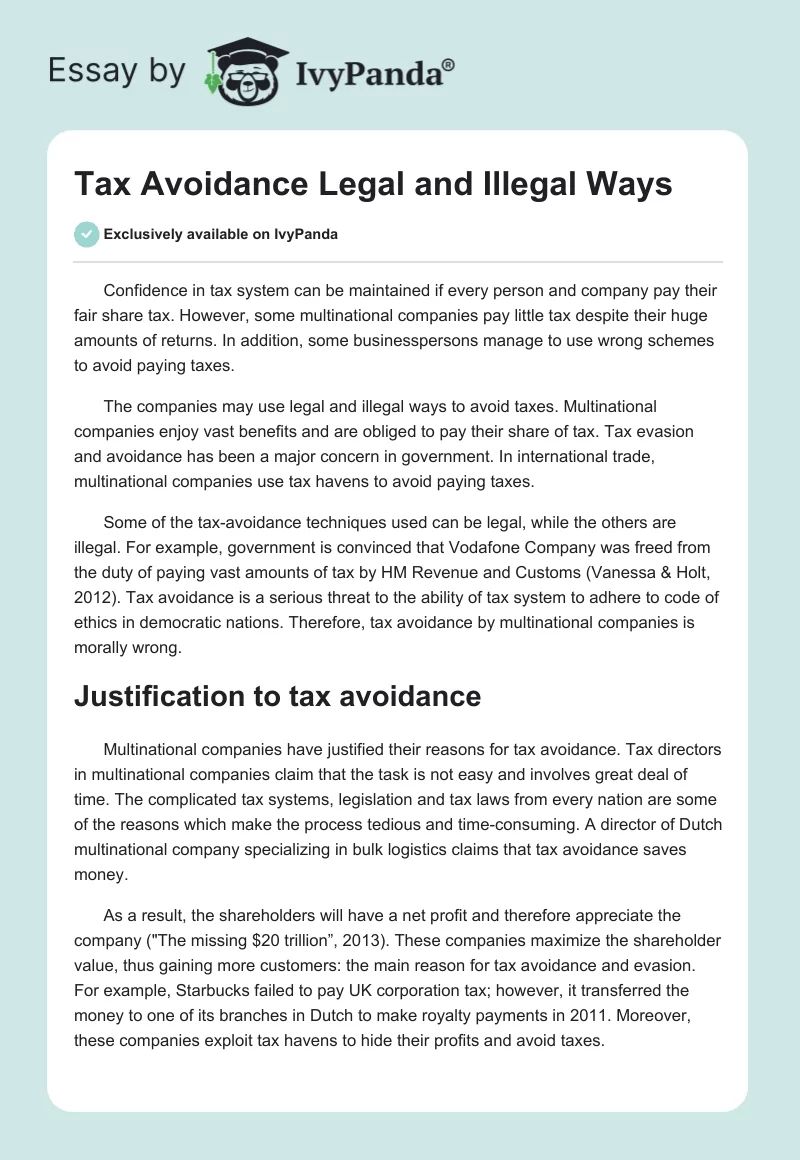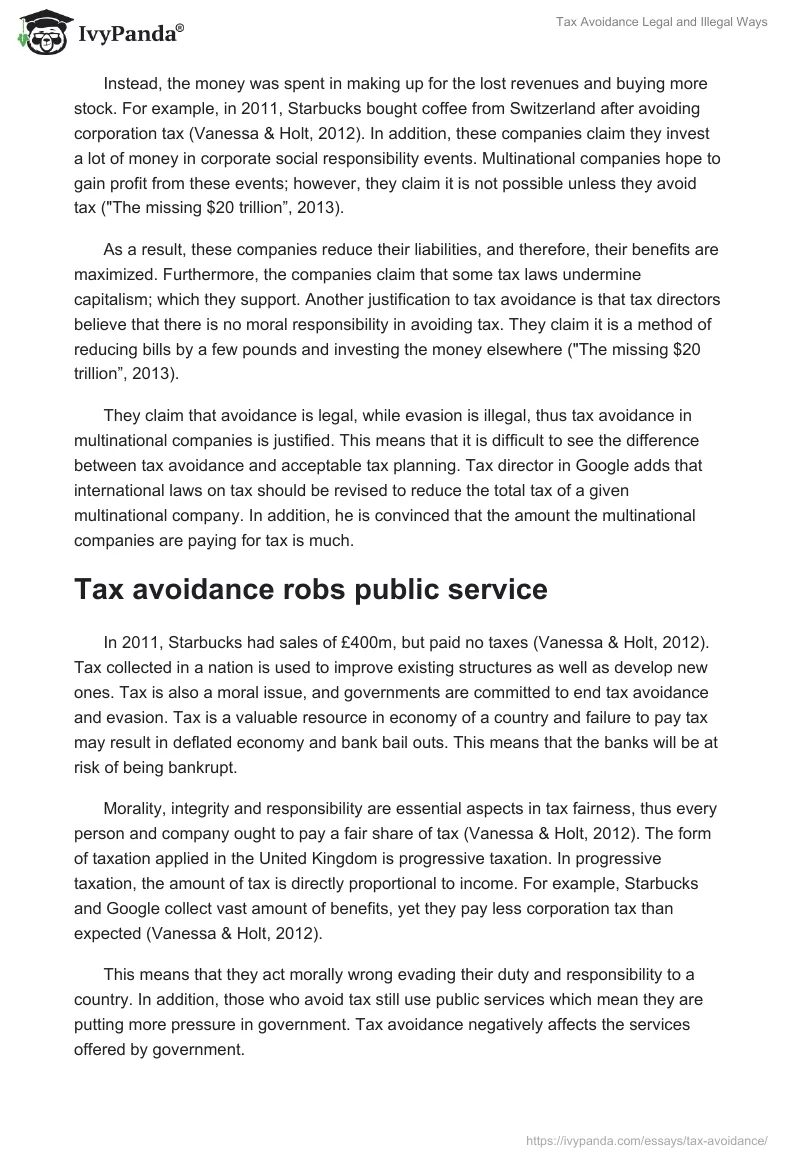Confidence in tax system can be maintained if every person and company pay their fair share tax. However, some multinational companies pay little tax despite their huge amounts of returns. In addition, some businesspersons manage to use wrong schemes to avoid paying taxes.
The companies may use legal and illegal ways to avoid taxes. Multinational companies enjoy vast benefits and are obliged to pay their share of tax. Tax evasion and avoidance has been a major concern in government. In international trade, multinational companies use tax havens to avoid paying taxes.
Some of the tax-avoidance techniques used can be legal, while the others are illegal. For example, government is convinced that Vodafone Company was freed from the duty of paying vast amounts of tax by HM Revenue and Customs (Vanessa & Holt, 2012). Tax avoidance is a serious threat to the ability of tax system to adhere to code of ethics in democratic nations. Therefore, tax avoidance by multinational companies is morally wrong.
Justification to tax avoidance
Multinational companies have justified their reasons for tax avoidance. Tax directors in multinational companies claim that the task is not easy and involves great deal of time. The complicated tax systems, legislation and tax laws from every nation are some of the reasons which make the process tedious and time-consuming. A director of Dutch multinational company specializing in bulk logistics claims that tax avoidance saves money.
As a result, the shareholders will have a net profit and therefore appreciate the company (“The missing $20 trillion”, 2013). These companies maximize the shareholder value, thus gaining more customers: the main reason for tax avoidance and evasion. For example, Starbucks failed to pay UK corporation tax; however, it transferred the money to one of its branches in Dutch to make royalty payments in 2011. Moreover, these companies exploit tax havens to hide their profits and avoid taxes.
Instead, the money was spent in making up for the lost revenues and buying more stock. For example, in 2011, Starbucks bought coffee from Switzerland after avoiding corporation tax (Vanessa & Holt, 2012). In addition, these companies claim they invest a lot of money in corporate social responsibility events. Multinational companies hope to gain profit from these events; however, they claim it is not possible unless they avoid tax (“The missing $20 trillion”, 2013).
As a result, these companies reduce their liabilities, and therefore, their benefits are maximized. Furthermore, the companies claim that some tax laws undermine capitalism; which they support. Another justification to tax avoidance is that tax directors believe that there is no moral responsibility in avoiding tax. They claim it is a method of reducing bills by a few pounds and investing the money elsewhere (“The missing $20 trillion”, 2013).
They claim that avoidance is legal, while evasion is illegal, thus tax avoidance in multinational companies is justified. This means that it is difficult to see the difference between tax avoidance and acceptable tax planning. Tax director in Google adds that international laws on tax should be revised to reduce the total tax of a given multinational company. In addition, he is convinced that the amount the multinational companies are paying for tax is much.
Tax avoidance robs public service
In 2011, Starbucks had sales of £400m, but paid no taxes (Vanessa & Holt, 2012). Tax collected in a nation is used to improve existing structures as well as develop new ones. Tax is also a moral issue, and governments are committed to end tax avoidance and evasion. Tax is a valuable resource in economy of a country and failure to pay tax may result in deflated economy and bank bail outs. This means that the banks will be at risk of being bankrupt.
Morality, integrity and responsibility are essential aspects in tax fairness, thus every person and company ought to pay a fair share of tax (Vanessa & Holt, 2012). The form of taxation applied in the United Kingdom is progressive taxation. In progressive taxation, the amount of tax is directly proportional to income. For example, Starbucks and Google collect vast amount of benefits, yet they pay less corporation tax than expected (Vanessa & Holt, 2012).
This means that they act morally wrong evading their duty and responsibility to a country. In addition, those who avoid tax still use public services which mean they are putting more pressure in government. Tax avoidance negatively affects the services offered by government.
Governments cannot defend the public interest appropriately. For example, the public is in need of quality health care, and government is obliged to provide for it. However, it is pressured because it lacks enough revenues to cater for its citizens. Tax avoidance affects the economy and self-reliability of a nation. It is morally wrong for these companies to negatively impact the economy of a nation by avoiding tax.
Through taxation, a government is able to collect revenues which can be used to improve the living standards of its subjects (“The missing $20 trillion”, 2013). This means that teachers, doctors and other public servants will have a good pay and better living standards. Equality is an important aspect in regard to the income tax and law. Individuals pay tax because they believe it is morally right. However, multinational companies fail to pay their fair share. This means that the value of equality is not met, and it is morally wrong.
Paying taxes is legal
Tax avoidance is not morally justifiable. Corporate tax directors have ruled out that it is illegal to avoid tax. For example, Starbucks and Google collect large amount of money out of their business activities. They run their businesses in many countries in the world.
For instance, to operate in the United Kingdom, the companies have a fair share which they are supposed to pay the government off as per the agreement.In addition, the UK exercises tax laws and international tax laws which govern the businesses (The price isn’t right”, 2013). This means that tax avoidance is a breach of the agreement and tax laws.
As a result, it is illegal to avoid tax. Paying taxes is a legal process, and multinational companies ought to pay their fair share of tax. It is believed that only ‘little people’ pay taxes (“little” in sense that their salary is less compared to benefits of multinational companies). In addition, some employees in multinational companies and rich individuals avoid tax (“The missing $20 trillion”, 2013). It is an act of selfishness for a company to collect benefits and pay less than it is required.
Moreover, it is illegal to devise ways of minimizing benefits in order to avoid tax as it is done by many multinational companies (“The missing $20 trillion”, 2013). In addition, the companies fail to contribute to the societies where they operate. It is important for multinational companies to pay their taxes to respect rule of law of a given land. Tax avoidance undermines the democracy of a country.
Nations should be able to cater for the needs of the citizens, and as a result of tax avoidance, many nations struggle to function appropriately. Countries lose revenues through illegal schemes in tax avoidance (“The price isn’t right”, 2013). To ensure equity in payment of taxes, governments need to address the challenges existing in taxation system. Organized schemes to avoid tax raise concerns about the credibility of tax collecting bodies and their systems.
Conclusion
Paying taxes is morally right and multinational companies should participate fully in the process. Democracies need to develop a country’s infrastructure and improve existing ones.
Governments need to provide adequate and social amenities to its citizens. To accomplish all these, governments need money for development. Taxation is one of the major avenues through which a government collects revenues (“The missing $20 trillion”, 2013). There is need to pay taxes to facilitate development activities in a nation. Tax avoidance robs public service (Vanessa & Holt, 2012).
As multinational companies maximize their benefits, they should also bear responsibility for the nation to pay their taxes. Paying taxes ensures constant supply of revenue to the budget, thus decreasing the incidents of bankruptcy in the country. In addition, a country is able to maintain its revenues (Vanessa & Holt, 2012). It is a legal responsibility to pay tax because there are laws governing the exercise in a given nation.
Paying corporation tax is important for a healthy relationship between the company and the society where it operates. Government ought to address the issues in taxation system in order to make rich individuals and multinationals responsible for paying tax (“The price isn’t right”, 2013). Transparency is one of the ways of addressing tax evasion by multinational companies. Government will be able to collect more information from the companies and share it better.
Bibliography
“The missing $20 trillion: How to stop companies and people dodging tax, in Delaware as well as Grand Cayman’ Tax havens“, The Economist. Web.
“The price isn’t right: Corporate profit-shifting has become big business“, The Economist. Web.
Vanessa, B, & G Holt, “Google, Amazon, Starbucks: The Rise of ‘tax shaming“, BBC News Magazine, 2012. Web.

 4.00
4.00
